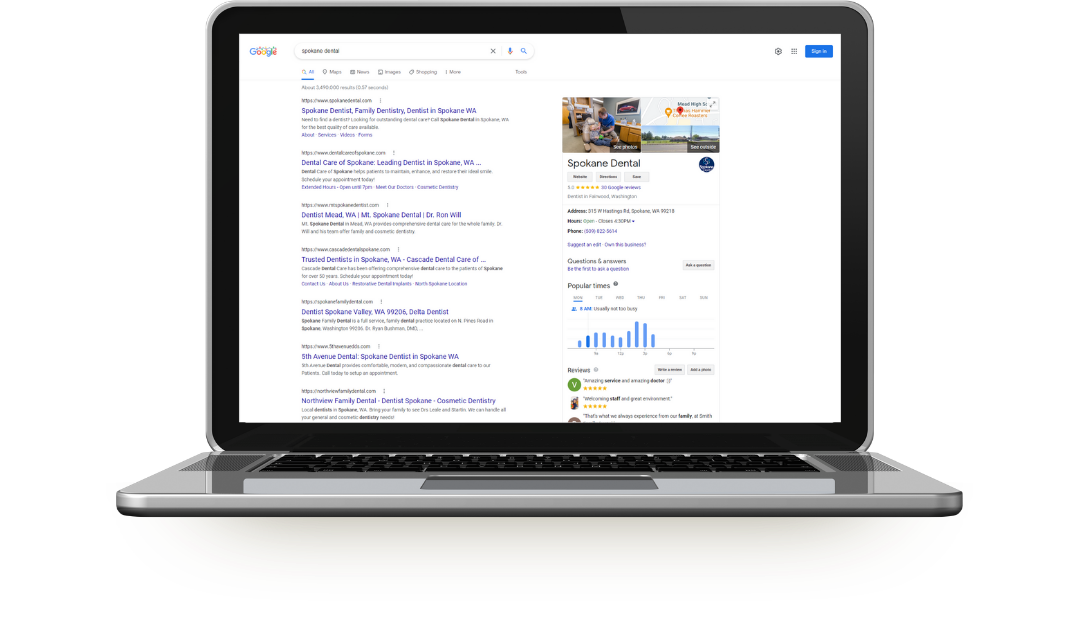When Patients Search, Precision Matters

When Patients Search, Precision Matters
Every day, people in pain or seeking a new smile begin with a search engine. They type “tooth pain relief,” “veneers cost,” or “dentist open now.” Yet despite being found online, many practices miss the chance to convert that search into a booked appointment. The key lies not simply in being visible—but in being visible to the right person, at the right time.
Pay-per-click (PPC) advertising is very important here. PPC gives you targeted exposure right away, unlike organic strategies that take time to build up. Pay-per-click (PPC) advertising is more than just digital ads for dental practices; it's a way to connect patients' needs with their ability to get to the dentist.
How PPC Aligns with Patient Needs
At its core, PPC means placing paid ads (often via Google) so that when someone searches for dental care, the practice’s ad appears prominently. The advertiser pays only when the ad is clicked—a model that rewards relevance over blanket exposure. According to DentalROI, the speed and measurability of PPC distinguish it from slower, traditional methods.
Because patients searching for care typically exhibit high urgency—whether from pain, aesthetics concerns, or functional issues—a PPC ad can reach them at just the moment they decide to act. But that only works when campaigns mirror real patient intent—down to the words they use, their location, and the time of day.
Crafting Campaigns That Speak to Patients
A campaign built around “dental implants” needs messaging, visuals, and steps that match what the patient expects: clarity about implant materials (zirconia, titanium), surgical phases, longevity data, and financing options. Redirecting them to a general “all services” page dilutes that precision and weakens trust.
Underneath the messaging lie strategic elements that often remain invisible to patients:
- Keyword architecture: One must identify not just “dentist,” but more specific, intention-laden phrases such as “same-day crown” or “emergency root canal,” while explicitly excluding irrelevant terms like “free dental school.”
- Ad relevance and quality: Search platforms measure whether an ad’s content, headline, and destination page collectively deliver the expected answer. Higher relevance both raises ad rank and lowers cost per click.
- Landing page continuity: If the ad is for gum disease, the landing page should start with information about periodontitis, including its stages, treatment plans, and how to take care of yourself afterward. It can't go off on things that are just for looks. Patients value a clear and smooth experience, even if they don't say so directly.
DentalROI provides full content, design, and optimization services to help campaigns stay on track with these goals.
The Patient’s Hidden Advantages
When a practice invests in PPC thoughtfully, patients benefit in subtle but meaningful ways:
- Faster access: A patient dealing with acute pain can more easily find and reach a provider, especially when ads are timed during office hours and lead directly to a phone call or booking tool.
- Relevant offerings, not noise: Because campaigns target specific services and are geographically confined, patients aren’t bombarded with irrelevant ads from too far away or for services they didn’t request.
- Transparency and education on demand: A well‑crafted ad and subsequent page can immediately explain the treatment, risks, benefits, and steps—helping anxious patients make informed decisions.
- Better practice capacity matching: Advertising can flex with the practice’s capacity. If certain services have open slots, the campaign can push them; when a provider is fully booked, ads can pull back—protecting patient expectation.
In effect, when PPC is handled with discipline, patients experience more clarity, less waste, and smoother pathways to care.
Bounds, Risks & When Caution Is Warranted
PPC is not a magic wand. In inexperienced hands, it becomes a money drain. Clicking doesn’t always equal booking, and “clicks with no conversions” are the bane of mismanaged campaigns.
Highly competitive services—veneers, full-mouth restorations—often drive up cost per click. The practice must be sure that the lifetime value of a new patient justifies the acquisition cost. Regulatory and ethical constraints (advertising promises, guarantees, clinical claims) must always be respected.
Also, PPC can't take the place of the trust that patients have in you because of your reputation, referrals, clinical excellence, and content marketing. A balanced approach—PPC plus organic presence—is necessary because pausing ads often means losing visibility right away.
Sustaining Performance Through Intelligence
A PPC campaign that is fully grown is never still. It changes every week. We get rid of keywords that aren't working, update the ad copy, change the bids, refine the negative terms, and test new messages. Over time, this constant trimming not only helps keep costs down, but it also gives you a better idea of who actually becomes a patient.
Proper analytics tie clicks to real conversions—calls, form submissions, booked appointments. Over time, the data reveals which demographics, times, or services yield the greatest return. DentalROI’s suite includes call tracking and dashboards to help link campaigns to measurable revenue.
It's also important to have realistic expectations. Some campaigns may start to break even after a few months, but to keep making money, they usually need six to twelve months of disciplined investment and changes.
Final Thoughts
When done with purpose, PPC in dentistry is more than just marketing; it's an extension of patient care. It attracts patients who are ready to take action, sets clear expectations, and speeds up access. But just like a precise restoration or periodontal therapy, success depends on paying attention to details, making sure everything is in the right place, and making small improvements all the time.
To explore how PPC might become a dependable pillar in your practice’s growth and patient experience, call 208‑627‑4225 for a consultation.



Please login to publish a comment.
Comments (0)